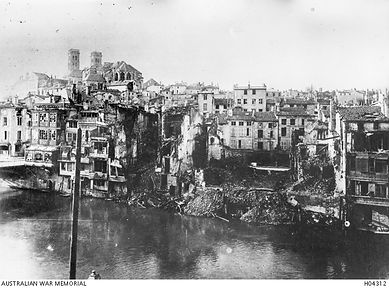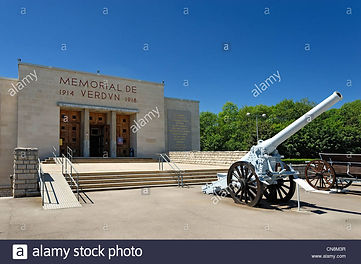Battle of Verdun
The Battle of Verdun is the longest ever battle in modern history, lasting from 21 February-15 December 1916. It was originally planned by German Chief of staff , Erich von Falkenhayn to secure victory for Germany on the Western Front. The aim was to obliterate the French army before the British arrived. Without the French, the allies would be severely crippled and will be unable to effectively fight against the Central Powers in the West.
To achieve aim, the Germans targeted a place which was paramount to the French National Pride, and strategic necessity - The River Meuse. Here Falkenhayn planned to use more than 1200 artillery pieces to destroy French units, whilst making limited use of German infantry to minimize his own casualties.

Verdun; River Meuse

French troops manning a captured German Maxim MG 08 machine gun (mounted on a sledge) at Fort Douaumont, Verdun.
On 21 February, 1916, 4am, a massive bombardment began. Five days into the battle, German forces captured Fort Douaumont, the largest and highest of the 19 forts protecting Verdun. The battle appeared to be going Falkenhayn's way. At this point, the seizure of ground became the priority and by the end of February, German losses at Verdun were similar to the French casualties.
In charge of the French 2nd army at Verdun was General Philippe Petain, reputed to be a master of defence. He organized his troop to to defend in depth by establishing a series of mutually supporting strongpoints, rather than concentrating his troops in the vulnerable trenches. Petain also rotated units through Verdun on a regular basis and whilst this exposed much of the French Army to the battle, it ensured troops did not spend long periods of time at the front. The French also greatly increased the number of artillery pieces at Verdun, leading to the Germans suffering equally from incessant shelling. The ability of the French to sustain the battle was due to ammunition and supplies arriving along the 'Voie Sacree', the Scared Way, a single road into Verdun kept open despite constant German shelling.
A German 17cm heavy artillery gun firing.

On 3rd March, German forces renewed their offensive. They pressed their attack on the west bank of the river meuse. In late April, General Robert Nivelle took over French command from Petain and began large-scale counter attacks. This gave the Germans a chance of returning to Falkenhayn's strategy but by this time all sense of the original concept was lost, replaced by a fixation to take Verdun. In early June the Germans took Fort Vaux after very tough fighting. This proved to be their final success. Efforts to continue the advance later that month failed
On 24 June, the Allied bombardment began on the Somme. The German offensive at Verdun was reduced in order to reinforce the Somme front. Nivelle seized his chance and attacked. His Second Army had artillery superiority and he employed new tactics based on specialist infantry sections armed with light machine guns, rifle grenades, mortars and light field guns. Even so, the Germans were not prepared to give ground. Casualties rose as villages such as Fleury changed hands several times. There was also terrible fighting for the forts taken by the Germans earlier in the battle before these too fell to the French.
I'm a paragraph. Click here to add your own text and edit me. It's easy.
The battle closed down on 15 December, as winter conditions and results of fighting on the Somme made further activity impossible. The French had lost 377,000 men and the Germans 330,000. Falkenhayn's plan to destroy the French army had failed. Even worse from a German perspective, the heavy losses at Verdun combined with even greater casualties suffered on the Somme to create a manpower crisis within the army that would become increasingly difficult to resolve as the war continued.
